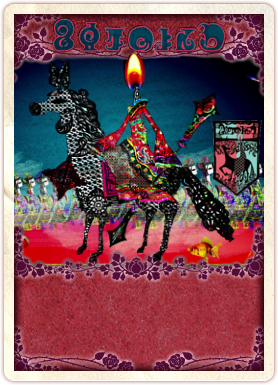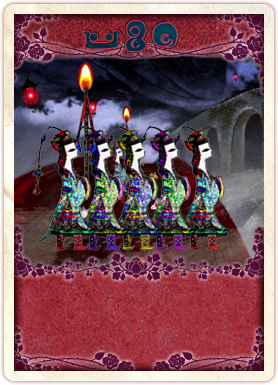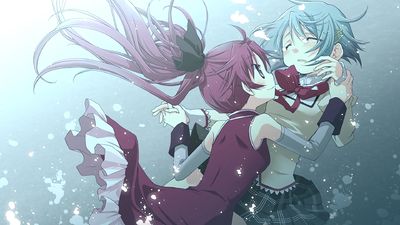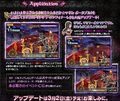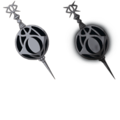User:Lyra: Difference between revisions
| (4 intermediate revisions by the same user not shown) | |||
| Line 55: | Line 55: | ||
==Trivia== | ==Trivia== | ||
*The official website for [[Puella Magi Madoka Magica Portable]] refers to Ophelia as the witch of ''wǔdàn'' (武旦). A [[wikipedia:Peking_opera#Dan|wǔdàn]] is a fierce female warrior in traditional Chinese opera. | *The official website for [[Puella Magi Madoka Magica Portable]] refers to Ophelia as the witch of ''wǔdàn'' (武旦). A [[wikipedia:Peking_opera#Dan|wǔdàn]] is a fierce female warrior in traditional Chinese opera. | ||
*Kyoko is known for the color red, her warrior ways, and her fiery attitude, all of which are incorporated in the main color palette of her barrier, the choice of wǔdàn witch, and the use of fire. | *Kyoko is known for the color red, her warrior ways, and her fiery attitude, all of which are incorporated in the main color palette of her barrier, the choice of wǔdàn witch, and the use of fire. | ||
| Line 61: | Line 61: | ||
== Symbolism and Other Observations == | == Symbolism and Other Observations == | ||
===Name=== | ===Name=== | ||
The name Ophelia is derived from the Greek οφελος (ophelos), meaning "help". This name was probably created by the 15th-century poet [[wikipedia:Jacopo_Sannazaro|Jacopo Sannazaro]] for a character in his poem 'Arcadia'.[http://www.behindthename.com/name/ophelia]. The name most appears in Shakespeare's [[wikipedia:Ophelia|Hamlet]]. Ophelia was a young woman who had a famous and highly romanticized suicide. Her character is linked to the idea of regret, corrupted innocence, and unrequited love. | |||
While she lived, Ophelia was torn between obeying her father Polonius' wishes and pursuing her love interest, Hamlet. She had a fear of intimacy and eventually went mad under the pressure of her father's death and her lover's rejection of her. Kyoko lost her family (her father being the driving force behind that) and was later spurned by Sayaka. Polonius was obsessed with keeping Ophelia pure, and repeatedly told her the importance of retaining innocence. Without that purity, he believed she would lose her worth. This mirrors the actions of Kyoko's father, who rejected her upon learning that she possessed her powers. Hamlet spurned her love in favor of his self-destructive quest to take revenge on his corrupt stepfather. This parallels Sayaka's rejection of Kyoko in favor of her own self-destructive quest to purge the world of witches and familiars. [[File:Madoka_BD_5_Menu_Art_2.jpg|right|400px]] | |||
At the end of her character arc, Ophelia commits suicide by drowning. The story of Ophelia's suicide is striking in a number of ways. First, her death seems to be passive: rather than straight-up committing suicide, as Gertrude (Hamlet's mother, the queen, who shares a name with the witch [[Gertrud]]) tells us, she accidentally falls in the water and then simply neglects to save herself from sinking. This seems to be a metaphor for the way Ophelia lives her life toward the end of the play – going with the flow, doing what her father tells her to do, rather making decisions for herself. Ophelia's garments "pull" her down, as if they had a mind of their own. Likewise, Kyoko followed wherever life lead her and was pulled down by her magical girl status. Ophelia is also described as being "mermaid-like" as she is consumed by the water. Gertrude also describes Ophelia as being like a "native" creature in the water. Kyoko killed herself in an attempt to reach Sayaka, who took on the form of a mermaid as [[Oktavia]], and whose transformation into a witch resonates with the features of water and the implied theme of drowning. It is also noted in Drama CD 4 that Kyoko cannot swim. | |||
Sayaka and Kyoko appear together underwater in the BD 5 artwork, shown to the right. | |||
===Candle Symbolism=== | ===Candle Symbolism=== | ||
Ophelia's head is a candle, which is strongly associated with Kyoko's own background. In [[Episode 7]], while Kyoko tells her story, after her father snaps, his head is consumed by a fire, which then sets fire to all the other puppets. Candles also often frequently appear next to him in the story. The parallels between to two suggests that Kyoko's despair is similar to her father's. | |||
Candles are also [[wikipedia:Ceremonial_use_of_lights#Candles|traditionally used in Christian worship]] to represent the light of Christ, reflecting Kyoko's religious upbringing and her father's priesthood. Candles are also associated with the festival of Advent; during Advent, a candle is kept in the household, which burns lower as Christmas approaches. This may be reflected in the red and green color scheme of her outfit and witch's kiss. In a more general religious sense, candles and fire represent light, a positive symbol of life and creation, which drives out the darkness, associated with death and decay. Kyoko's assertion that she and her father were "going to save the world together" may parallel the illuminating properties of the candle. | |||
In addition, Kyoko is associated with the element of fire and the color red, in opposition to Sayaka's water symbolism and the color blue. The use of fire and red in Ophelia's design reflects this. | |||
===Headless Horseman Legend=== | ===Headless Horseman Legend=== | ||
Ophelia can be thought of as a [[wikipedia:Headless_Horseman|headless horseman]]. There are several Germanic tales associated with the legend. | |||
One is set near Dresden in eastern Germany. In this tale, a woman from Dresden goes out early one Sunday morning to gather acorns in a forest. At a place called "Lost Waters", she hears a hunting horn. When she hears it again, she turns around she sees a headless man in a long grey coat sitting on a grey horse. The grey horse matches the horse Ophelia rides. | |||
In another German tale, set in Brunswick, a headless horseman called "the wild huntsman" blows a horn which warns hunters not to ride the next day, because they will meet with an accident. In this case, the horseman is a symbol of ill omen. In some other versions of the tale, he seeks out the perpetrators of capital crimes. In others, he has a pack of black hounds with tongues of fire. | |||
===Fish=== | ===Fish=== | ||
There are various colored fish swimming around her barrier. Fish have many symbolic meanings in a wide variety of religions. Most notably, the fish was used in early Christianity (called the [[wikipedia:Ichthys|ICHTHYS]]) as a secret symbol of Christian faith, again reflecting Christian background comes from. | |||
In Buddhism, fish represent the practice of the dharma, which results in the ability to navigate the cycle of rebirth freely, like a fish. One of the [[wikipedia:Ashtamangala|eight auspicious signs]] is a pair of goldfish as well. | |||
In many cultures, the fish is a symbol of wealth and prosperity, as well as change and adaptability. This is somewhat ironic, considering that Kyoko grew up in a poor household, and is quite stubborn and maladaptive. | |||
===Horse=== | ===Horse=== | ||
| Line 73: | Line 94: | ||
===Familiars=== | ===Familiars=== | ||
rmaid_unicorn_ep_9.jpg|the symbolism of the unicorn]] represents innocence. The fact that Ophelia is riding a horse, instead of a unicorn, has been speculated that the horse represents the loss of innocence and nobility. The image ingrains the idea that the unicorn has lost its horn along with its splendor and that it has become a regular equestrian animal. | |||
** The horse's ears are unusually pointed, which make them resemble horns. | ** The horse's ears are unusually pointed, which make them resemble horns. | ||
**According to Chinese folklore, each animal is associated with certain personality traits, and those born in the year of the horse are intelligent, independent, and free-spirited. | **According to Chinese folklore, each animal is associated with certain personality traits, and those born in the year of the horse are intelligent, independent, and free-spirited. | ||
| Line 136: | Line 132: | ||
== Gallery == | == Gallery == | ||
<gallery captionalign="left" position="center"> | <gallery captionalign="left" position="center"> | ||
File:Dengeki_ps_kyoko_witch_form.jpg | |||
File:Dengeki_PlayStation_2012-03_05.jpg|Ophelia and her familiars. | File:Dengeki_PlayStation_2012-03_05.jpg|Ophelia and her familiars. | ||
File:Dengeki_PlayStation_2012-03_06.jpg | File:Dengeki_PlayStation_2012-03_06.jpg | ||
Revision as of 19:34, 7 March 2015
The Sandbox Witch (herein lies one editor's attempt to audit some 20 pages)
Proposed re-edit of Ophelia's page (because it needs it so fucking sorely)
Ophelia (OPHELIA) is the witch form of Kyoko Sakura, making an appearance in Madoka Magica Portable.
The witch of wǔdàn. Her nature is desperation. A witch who eternally wanders through the fog, with hollow footsteps. She can no longer remember what the horse that always accompanies her was. | |||||||||||
Description
Ophelia wears a long, mostly red garment that vaguely resembles her magical girl outfit, and brandishes a two-sided spear. The witch rides a grey horse that wears a large red diamond symbol around its neck. While different from that of her father's religion, it resembles it in shape and design. Most strikingly, the witch's head is a candle flame.
Ophelia can create duplicates of herself with a version of Rosso Fantasma, an ability previously lost to Kyoko. These duplicates can attack with as much ferocity as the witch. The witch can also transform herself into a spear and launch herself for a ranged attack.
Familiars
The wǔdàn witch's minions. Their duty is marching. They perpetually walk through the fog in an orderly fashion. Their mistress, the witch, does not approach them. | |||||||||
Description
Ophelia's familiars are colorfully attired warriors that march around her barrier. They resemble female warriors in Chinese stage plays.
Some of these familiars attack with a dragon's head that emerges from their neck, while others can summon other familiars with a bell, and attack with a long-range fire attack. This hybrid combat ability reflects Kyoko's own skill with both ranged and melee attacks.
Translations
From the March 2012 Dengeki PlayStation
[Delete this entire section and relegate to see also if need be]
Barrier
Ophelia's barrier largely comprises several narrow stone bridges, reminiscent of the Great Wall of China, illuminated by floating red lanterns. The walls and floors of her barrier are largely unadorned and lined with dark red bricks. The sky is a murky blue, and overcast. In the distance, small colorful fish make up part of the scenery. The witch herself is found in a narrow, confined area blocked off on either side by woven barriers, reminiscent of the alley where Kyoko fought Sayaka in Episode 5.
Trivia
- The official website for Puella Magi Madoka Magica Portable refers to Ophelia as the witch of wǔdàn (武旦). A wǔdàn is a fierce female warrior in traditional Chinese opera.
- Kyoko is known for the color red, her warrior ways, and her fiery attitude, all of which are incorporated in the main color palette of her barrier, the choice of wǔdàn witch, and the use of fire.
Symbolism and Other Observations
Name
The name Ophelia is derived from the Greek οφελος (ophelos), meaning "help". This name was probably created by the 15th-century poet Jacopo Sannazaro for a character in his poem 'Arcadia'.[1]. The name most appears in Shakespeare's Hamlet. Ophelia was a young woman who had a famous and highly romanticized suicide. Her character is linked to the idea of regret, corrupted innocence, and unrequited love.
While she lived, Ophelia was torn between obeying her father Polonius' wishes and pursuing her love interest, Hamlet. She had a fear of intimacy and eventually went mad under the pressure of her father's death and her lover's rejection of her. Kyoko lost her family (her father being the driving force behind that) and was later spurned by Sayaka. Polonius was obsessed with keeping Ophelia pure, and repeatedly told her the importance of retaining innocence. Without that purity, he believed she would lose her worth. This mirrors the actions of Kyoko's father, who rejected her upon learning that she possessed her powers. Hamlet spurned her love in favor of his self-destructive quest to take revenge on his corrupt stepfather. This parallels Sayaka's rejection of Kyoko in favor of her own self-destructive quest to purge the world of witches and familiars.
At the end of her character arc, Ophelia commits suicide by drowning. The story of Ophelia's suicide is striking in a number of ways. First, her death seems to be passive: rather than straight-up committing suicide, as Gertrude (Hamlet's mother, the queen, who shares a name with the witch Gertrud) tells us, she accidentally falls in the water and then simply neglects to save herself from sinking. This seems to be a metaphor for the way Ophelia lives her life toward the end of the play – going with the flow, doing what her father tells her to do, rather making decisions for herself. Ophelia's garments "pull" her down, as if they had a mind of their own. Likewise, Kyoko followed wherever life lead her and was pulled down by her magical girl status. Ophelia is also described as being "mermaid-like" as she is consumed by the water. Gertrude also describes Ophelia as being like a "native" creature in the water. Kyoko killed herself in an attempt to reach Sayaka, who took on the form of a mermaid as Oktavia, and whose transformation into a witch resonates with the features of water and the implied theme of drowning. It is also noted in Drama CD 4 that Kyoko cannot swim.
Sayaka and Kyoko appear together underwater in the BD 5 artwork, shown to the right.
Candle Symbolism
Ophelia's head is a candle, which is strongly associated with Kyoko's own background. In Episode 7, while Kyoko tells her story, after her father snaps, his head is consumed by a fire, which then sets fire to all the other puppets. Candles also often frequently appear next to him in the story. The parallels between to two suggests that Kyoko's despair is similar to her father's.
Candles are also traditionally used in Christian worship to represent the light of Christ, reflecting Kyoko's religious upbringing and her father's priesthood. Candles are also associated with the festival of Advent; during Advent, a candle is kept in the household, which burns lower as Christmas approaches. This may be reflected in the red and green color scheme of her outfit and witch's kiss. In a more general religious sense, candles and fire represent light, a positive symbol of life and creation, which drives out the darkness, associated with death and decay. Kyoko's assertion that she and her father were "going to save the world together" may parallel the illuminating properties of the candle.
In addition, Kyoko is associated with the element of fire and the color red, in opposition to Sayaka's water symbolism and the color blue. The use of fire and red in Ophelia's design reflects this.
Headless Horseman Legend
Ophelia can be thought of as a headless horseman. There are several Germanic tales associated with the legend.
One is set near Dresden in eastern Germany. In this tale, a woman from Dresden goes out early one Sunday morning to gather acorns in a forest. At a place called "Lost Waters", she hears a hunting horn. When she hears it again, she turns around she sees a headless man in a long grey coat sitting on a grey horse. The grey horse matches the horse Ophelia rides.
In another German tale, set in Brunswick, a headless horseman called "the wild huntsman" blows a horn which warns hunters not to ride the next day, because they will meet with an accident. In this case, the horseman is a symbol of ill omen. In some other versions of the tale, he seeks out the perpetrators of capital crimes. In others, he has a pack of black hounds with tongues of fire.
Fish
There are various colored fish swimming around her barrier. Fish have many symbolic meanings in a wide variety of religions. Most notably, the fish was used in early Christianity (called the ICHTHYS) as a secret symbol of Christian faith, again reflecting Christian background comes from.
In Buddhism, fish represent the practice of the dharma, which results in the ability to navigate the cycle of rebirth freely, like a fish. One of the eight auspicious signs is a pair of goldfish as well.
In many cultures, the fish is a symbol of wealth and prosperity, as well as change and adaptability. This is somewhat ironic, considering that Kyoko grew up in a poor household, and is quite stubborn and maladaptive.
Horse
Knight-Errant Trope
Familiars
rmaid_unicorn_ep_9.jpg|the symbolism of the unicorn]] represents innocence. The fact that Ophelia is riding a horse, instead of a unicorn, has been speculated that the horse represents the loss of innocence and nobility. The image ingrains the idea that the unicorn has lost its horn along with its splendor and that it has become a regular equestrian animal.
- The horse's ears are unusually pointed, which make them resemble horns.
- According to Chinese folklore, each animal is associated with certain personality traits, and those born in the year of the horse are intelligent, independent, and free-spirited.
- There is some reason to believe that Poseidon, like other water gods, was originally conceived under the form of a horse. In Greek art, Poseidon rides a chariot that was pulled by a hippocampus or by horses that could ride on the sea, and sailors sometimes drowned horses as a sacrifice to Poseidon to ensure a safe voyage.
- Homer describes Poseidon, who was god of horses (Poseidon Hippios), earthquakes, and the sea, drawn by "brazen-hoofed" horses over the sea's surface.
- Tacitus (Germania) mentions the use of white horses for divination by the Germanic tribes, where the behavior of a white stallion could decide peace or war.
- White horses (which are rarer than other colours of horse) have a special significance in the mythologies of cultures around the world. They are often associated with the sun chariot, with warrior-heroes, with fertility (in both mare and stallion manifestations), or with an end-of-time savior, but other interpretations exist as well. Both truly white horses and the more common grey horses, with completely white hair coats, were identified as "white" by various religious and cultural traditions.
- In the New Testament, the Four Horsemen of the Apocalypse include one seated on a white horse and one on a pale horse - the pale horse carried the rider, Death. However, the Greek word translated as pale is often interpreted as sickly green or ashen grey rather than white. Later in the Book of Revelation, Christ rides a white horse out of heaven at the head of the armies of heaven to judge and make war upon the earth.
- Saint George, the patron saint of horsemen among other things, rides a white horse in the tale of Saint George and the Dragon.
- It is speculated that perhaps the guilt that Kyoko carried with her due to her failure to protect her family, and later Sayaka, weighted too much on her causing Kyoko to turn into a witch.
- The imagery of Ophelia riding a horse is speculated to evoke the imagery of "Knight, Death and the Devil" (Ritter, Tod und Teufel), a large 1513 engraving, one of the three "master prints" of the German artist Albrecht Dürer.
- If an unicorn is a symbol of purity and grace, then this may imply Kyoko lost both before she turned into the witch.
- Ophelia could be described as a (fallen) Knight-errant: a figure of medieval chivalric romance literature. The adjective errant (meaning "wandering, roving") indicates how the knight-errant would wander the land in search of adventures to prove his chivalric virtues, either in knightly duels (pas d'armes) or in some other pursuit of courtly love.
- The template of the knight-errant are the heroes of the Round Table of the Arthurian cycle such as Gawain, Lancelot and Perceval. The quest par excellance in pursuit of which these knights wander the lands is the Holy Grail.
- A knight-errant typically performed all his deeds in the name of a lady, and invoked her name before performing an exploit. In more sublimated forms of knight-errantry, pure metaphysical idealism rather than romantic inspiration motivated the knight-errant (as in the case of Sir Galahad). Such a knight might well be outside the structure of feudalism, wandering solely to perform noble exploits (and perhaps to find a lord to give his service to), but might also be in service to a king or lord, traveling either in pursuit of a specific duty that his overlord charged him with, or to put down evildoers in general. This quest sends a knight on adventures much like the ones of a knight in search of them, as he happens on the same marvels.
- The knight-errant stock character became the trope of the "knight in shining armour" in depiction of the Middle Ages in popular culture, and the term came to be used also outside of medieval drama.
- In Arthurian literature, the Holy Grail is a dish, plate, stone or cup, and was used to collect and store the blood of Christ at the Crucifixion. In Christian tradition the Holy Chalice is the vessel which Jesus used at the Last Supper to serve the wine. Not to be confused with the Grail legend, which is an entirely different and pervasive tradition concerning the cup of the Last Supper.
- In Episode 7, when Kyoko's family is murdered and their paper figures dismembered, their bodies and their blood drop into what appears to be a bathroom basin. The basin has a bowl shape form that could be interpreted to be in contrast to a baptism basin or the Holy Grail, the vessel used to store Jesus' blood.
- If Ophelia is an Knight-errant in search for a quest, perhaps she is in a quest for her own Holy Grail: The salvation of her family. This salvation could be metaphysical or spiritual but it is more likely her actual desire to save her family from physical death. As a Witch she probably has forgotten that her family is already dead, making Ophelia's own hero journey rendered useless.
- In Arthurian literature, the Holy Grail is a dish, plate, stone or cup, and was used to collect and store the blood of Christ at the Crucifixion. In Christian tradition the Holy Chalice is the vessel which Jesus used at the Last Supper to serve the wine. Not to be confused with the Grail legend, which is an entirely different and pervasive tradition concerning the cup of the Last Supper.
- Another interpretation is that Ophelia is a knight forever wandering to find something to protect, and never able to find it.
- Ophelia's familiars are based off the rokurokubi, a type of Japanese supernatural creature that look like normal humans by day but gain the ability to elongate their necks at night.
- The rokurokubi are related to the nukekubi, a similar monster that detaches it's head completely. This may tie into Ophelia resembling a headless horseman.
- When Ophelia's familiars extend their necks they resemble dragon heads, which has a significant symbolism.
- In many Asian cultures dragons are revered as representative of the primal forces of nature, religion and the universe. They are associated with wisdom -often said to be wiser than humans- and longevity. They are commonly said to possess some form of magic or other supernatural powers, and are often associated with wells, rain, and rivers. In some cultures, they are also said to be capable of human speech. In some traditions dragons are said to have taught humans to talk. Asian dragons are typically depicted as large, wingless, serpentine creatures with clawed feet.
- The ringing of bells have their place in religious ceremonies, rituals and traditions:
- Ophelia's horse lack of a bridle and a rein is speculated to be an indication that the horse, while still at the service of Ophelia with no restrains, remains wild and free.
- However, it has been suggested, like all familiars, that the horse could still be under the control of Ophelia by magic and bridles and reins are unnecessary.
- Other believe the horse is literally a part of Ophelia's body.
- Ophelia's witch kiss looks like a heraldic banner.
- In German, the word banner was originally meant an official edict or proclamation. Such written orders often prohibited some form of human activity, bandum assumed the meaning of a ban, control, interdict or excommunication. Banns has the same origin meaning an official proclamation, and abandon means to change loyalty or disobey orders, semantically "to leave the cloth or flag".
- Ophelia's horse might also represent Kyoko's appetite. Horses will constantly eat if food is available, similar to Kyoko's eating habits. The phrases "Hungry as a horse" and "Eat like a horse" can contribute to the link between Ophelia's horse and Kyoko's appetite.
- Ophelia's connection to fire might also be a reference to Kyoko's appetite, as fire is associated with indiscriminate consumption.
Gallery
Fanart
This section contains fanart images
Everything in the following fan gallery is created, or the comments accompanying them are created, for entertainment value and should not be confused with actual canon events of the Puella Magi franchise.- Ophelia witch card.jpg
- Ophelia form human fanart badass.jpg
- Ophelia fanart witch form.jpg
- Ophelia-art.jpg
- 25337862.jpg
- Ophelia Grin Badass.jpg
Even as a witch Kyoko remains badass
- 25323945.jpg
- Candeloro and Ophelia.jpg
- 25292387.jpg
- 25296777 p0.jpg
- 25296777 p2.jpg
- OPHELIA black white artwork.jpg
- Ophelia kyouko sayaka cartoon raw fanart.jpg
- Candeloro and ophelia fanart together.jpg
- Ophelia horse fanart witch human form.jpg
- 26378453 p2.jpg
- SayakaOphelia Dawwwnnnn.jpg
- Ophelia March.jpg
Nothing left for me in this world right? What are you again by the way?
- Lit the flame of love with my prayers.jpg
- Ophelia Familiars OMFG.jpg
- And then Kyoko was a pokemon.jpg
Magical girls turn into pokemons?!
- Witch Girl Talk.jpg
"And then I said..."
"Uh-huh"
